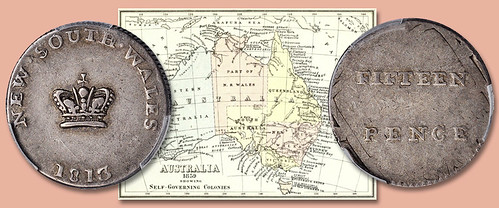
PREV ARTICLE
NEXT ARTICLE
FULL ISSUE
PREV FULL ISSUE
1813 NEW SOUTH WALES 15 PENCE 'DUMP'Stack's Bowers Senior Numismatist and Cataloger Jeremy Bostwick published a blog article this week on the "Dump" and Australia's first coinage. In just a few short paragraphs Jeremy clearly lays out the need for and the thinking behind these fascinating pieces, and the reason for their great rarity today. -Editor

Having a native population going back some 60,000 years, Australia was first discovered by Europeans when the Dutch arrived in the early 17th century. A century later, the British arrived and in turn claimed half of the continent for themselves. The initial colony established there was New South Wales, and the British utilized this outpost as a penal colony to which the dominion's convicts could be sent. Not just prisoners would populate this southern realm, however, as the number of inhabitants in general grew rapidly in the late 17th- and early 18th centuries. So great was the growth that a complex bartering system existed, due to the lack of currency. To alleviate this shortage and ensure that the resulting coinage would not simply leave the colony as trading partners departed, a plan was devised whereby Spanish colonial 8 Reales—a trade coin par excellence around the world—would be holed out. The "holed" pieces would then be stamped around the central hole identifying the colony, date, and—most importantly—the value. As these "Holey Dollars" were valued within New South Wales at 5 Shillings (about 20% more than they would be valued anywhere else on account of the loss of silver), their purchase power meant that they would remain in the colony averting another shortage. To make this process financially efficient, the resulting holes or plugs that were left over from the cored 8 Reales were also utilized—this time as a subsidiary coinage valued at 15 Pence. Again, the value stated on these repurposed plugs was higher in New South Wales than anywhere else, keeping them domestic as well. In late 1812, 40,000 of these 8 Reales arrived in Australia, thus initiating the holing process; some eight months later, the coinage—both large and small—was made official and circulated quite extensively for a decade. As more British coinage would continue to find its way to the colony, however, the necessity of these issues dwindled; they were recalled in 1822 and eventually demonetized in 1829. As nearly everyone took advantage of the redemption program to exchange for British coinage, the survival rate of both denominations is quite low. Owing to their vast usage during that decade, many survivors are in heavily worn condition. Our upcoming January 2021 auction—an officially sanctioned auction of the NYINC—will feature one of these storied fractional issues. This 15 Pence denomination—affectionately known as a "Dump"—remains in an impressive state of preservation given the aforementioned degree of circulation. Grading PCGS VF-35, it is exceeded in the PCGS census by just one other specimen for its particular type.
To read the complete article, see:
To read earlier E-Sylum articles, see:

Wayne Homren, Editor The Numismatic Bibliomania Society is a non-profit organization promoting numismatic literature. See our web site at coinbooks.org. To submit items for publication in The E-Sylum, write to the Editor at this address: whomren@gmail.com To subscribe go to: https://my.binhost.com/lists/listinfo/esylum All Rights Reserved. NBS Home Page Contact the NBS webmaster 
|